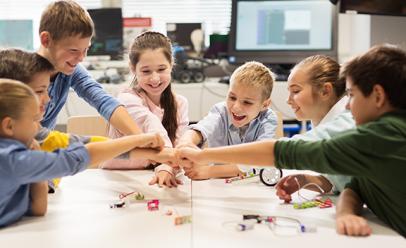 By: Kendall Hunt RPD with contributions from the editorial team
By: Kendall Hunt RPD with contributions from the editorial team
Customized curriculum, such as Pathways2.0 and ByDesign Science, emphasizes collaborative learning because of its proven positive impacts on the student experience. There are many benefits of collaborative learning, but students don’t always see it that way. So many students have expressed their distaste for group projects that there’s now an official term for the phenomenon: “group-hate,” or the negative feelings that people have toward working in groups.
Whether it is slacking peers, grading fears, or arguments and tears, students have expressed their distaste for group projects. That is why it is important to change their mindset with a new approach — collaborative learning.
In collaborative learning, students are working with one another to complete tasks and achieve a common goal, rather than simply working on the same task at the same time. This lets you ease student fears regarding one insidious aspect of group work, some group members doing more than their fair share of the work while others do less. Explain to students that rather than all working together on one nebulous giant project, they’ll each have a specific assignment that then comes together to form something bigger. For example, you could design a project in which each student is responsible for a specific decade in relation to a topic, and the combined decades form a complete timeline when assembled by the group.
So, what is “group-hate”?
Simply, a negative reaction to group work. Individuals will avoid working in groups and express their sincere dislike for academic group activities for four common reasons: grades, interpersonal considerations, poor outcomes of group work, and group organization factors.
What can we do to change their minds?
Let them vent.
One helpful exercise to establish group norms can be a “best/worst” activity, where kids brainstorm a list of qualities of the best group project, they were a part of, then the qualities of the worst. This not only lets kids voice their frustrations, but it also proves to them that they personally have experienced positives in collaborative learning. After all, you can assure students that collaborative learning gives quieter students a chance to speak up and gain confidence, or that it lets every student use their preferred learning style, but it will be so much more powerful if they hear their peers (or themselves) say so!
Set clear grading expectations.
One reason students get nervous about group work is because they don’t want their peers’ work to have an impact on their own grades. To combat this, create separate rubrics for individual student work and the work of the group. If you will be incorporating peer feedback as part of the final grade, let students know up front, and ensure they understand how they will be evaluated by their peers. You should also make your students aware that their grade for the collaborative learning assignment isn’t solely dependent on the final product. The process itself is just as important.
It doesn’t all have to go smoothly.
However, that doesn’t mean the process must be perfect. In fact, challenges are one of the advantages of collaborative learning. Students are no longer spoon-fed information from a teacher and must grasp the concept of independent learning. This struggle can inspire group hate for students who rarely experience academic failure. Encourage a growth mind-set by requiring each student to keep a journal of the struggles and successes their group encounters on their way to the goal. During evaluation, they’ll have a concrete record of the times they used skills in clarification, persuasion, and compromise to present ideas in ways that their group members could understand.
Be strategic in group design.
When you create groups, it’s best to have a mix of ability levels and learning styles so that students can learn from one another. If you create diverse groups, you increase the chances that each student will have the opportunity to get a concept explained to them in a completely new light. That experience often sticks with a student— “Remember when Hannah taught me that cool trick for reading sight words?”—and will leave them with a more pleasant memory of collaborative learning.
Avoid hearing groans when you announce, “Time for collaborative learning!” with these simple and effective ways of reframing collaborative learning.